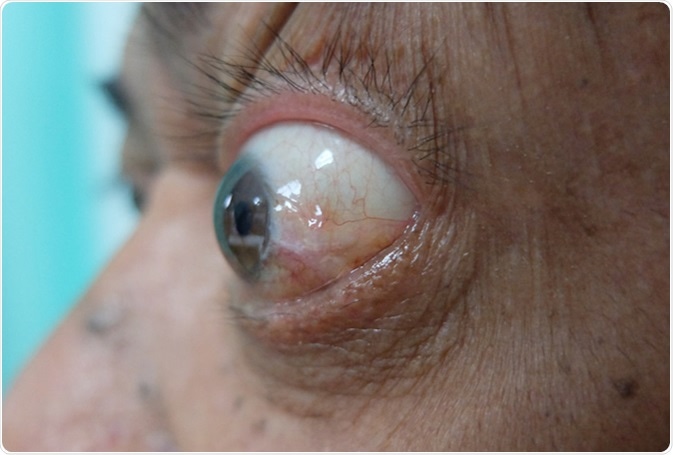Exophthalmos refers to an abnormal protrusion of the eyeball. Also called exophthalmia, exorbitism, or proptosis, this condition can affect one or both eyes (unilateral or bilateral) and is typically associated with an underlying medical condition.
Exophthalmos is the protrusion, or projection of the eyeball outwards. The condition arises in response to a build-up of fat, muscle or tissue behind the eye, reducing the amount of space in the eye socket. This forces the eyeball forward.

Exopthalmos or prorotosis described as protrusion of the eyeball. Image Credit: Casa Nayafana / Shutterstock
Skip to
What are the causes of exophthalmos?
The underlying cause of exophthalmos determines whether the condition is bilateral or unilateral. One of the most common causes of exophthalmos is Graves’ disease, an autoimmune condition that affects the thyroid. As with all autoimmune conditions, Graves’ disease occurs when the immune system of the body mistakenly attacks healthy tissue, which in this case is the thyroid gland. This leads to an overactive thyroid gland or hyperthyroidism.
Due to hyperthyroidism, the tissues and muscles around the eyes become inflamed or swollen, contributing to exophthalmos. Scarring and swelling in the eye muscles cause crowding of the bony orbit, which pushes the eyes forward.
Other common causes of exophthalmos include eye trauma, abnormally-shaped blood vessels behind the eyes, cancerous tumors, infection of the eye socket and bleeding within the eye.
What are the signs and symptoms of exophthalmos?
The main symptom of exophthalmos is an abnormal bulging of the eye. There are other signs and symptoms, including corneal dryness, pain, discomfort, difficulty moving the eyes, scarring, and difficulty fully closing the eyes when sleeping or blinking.
How is exophthalmos diagnosed?
One of the most common ways to diagnose exophthalmos is through a physical assessment of an ophthalmologist. Exophthalmos is easily recognizable from the appearance of the eyeballs. The doctor can see the eyeballs protruding from the sockets.
If the doctor suspects thyroid disease, he may request a blood test to examine the function of the thyroid gland. Eye tests can detect the ability of the patient to move the eyes. Also, the doctor will measure the degree of eyeball protrusion using an exophthalmometer.
If the doctor suspects an abnormal growth behind the eyes, the doctor may request a computerized tomography (CT) scan or a magnetic resonance imaging (MRI) scan. These diagnostic scans allow the doctor to examine the eye socket in detail to detect tumor growth.
How is exophthalmos treated?
The treatment of exophthalmos depends on its cause. If it is caused by a thyroid problem, treatment will focus on returning the thyroid hormone levels to normal. Some medications can correct the level of thyroid hormones in the blood. Though this treatment won’t improve the eye problem, it can help prevent the condition’s progression.
If the condition is caused by swelling or inflammation, corticosteroids may be prescribed. Corticosteroids help treat severe cases of thyroid eye disease if the eyes are inflamed or painful.
In some cases of exophthalmos, surgery may be necessary. Usually, surgery is recommended if the patient has a problem with the connection of veins and arteries in the eyes.
Another surgical procedure is performed if there is an impairment of visual acuity. The operation focuses on decompressing the orbit, aiming to increase its capacity.
The longer the patient has untreated exophthalmos, the more severe it can get and the more difficult it is to treat. Hence, it’s crucial to seek medical help if exophthalmos becomes evident, so treatment can be started right away.
Exophthalmos is a symptom of an underlying medical condition. The treatment often relies on addressing the main problem first.
Further Reading
Last Updated: May 6, 2019